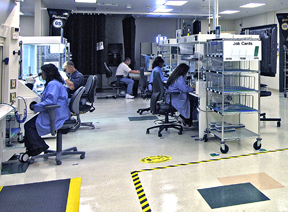
Sandia National Laboratories’ Center 2700 — the Responsive Neutron Generator Product Deployment Center — has a vision: to be the model of operational excellence for the entire nuclear weapons complex. Now that it’s won the prestigious and coveted Shingo Prize for 2008 — the first and only public sector organization so honored — it can validate that it is on track toward achieving that vision.
Shingo, more than any other business prize, promotes awareness of lean concepts and recognizes companies in the US, Canada, and Mexico that achieve world-class status in lean transformation.
BusinessWeek, as authoritative a voice as there is in matters related to US business activity, has called the Shingo Prize “the Nobel Prize for manufacturing” because it establishes a standard for excellence through focused improvements in core manufacturing and business processes.
The Shingo Prize was established in 1988 by the John M. Huntsman School of Business at Utah State University. The prize is named for Japanese industrial engineer Shigeo Shingo, who distinguished himself as one of the world’s leading experts in improving manufacturing processes. He helped create and write about many aspects of the revolutionary manufacturing practices that comprise the renowned Toyota Production System.
This year’s award isn’t Center 2700’s first encounter with the Shingo organization. In 2006, the center won a Shingo bronze medallion for its implementation of lean principles in its production activities. The 2008 award is broader in scope, recognizing the center for its implementation of lean principles across the entire neutron generator life cycle activities.
Great feedback from first visit
That 2006 prize, and the activities leading up to it, offered a real learning opportunity, says Center Director Kathleen McCaughey. “Part of the [prize competition] process,” she says, “is to get a feedback report from the Shingo organization. We got some great feedback, which motivated us to put an action plan in place.”
That action plan — which Kathleen and her team approached with the fervor of a campaign — included implementing lean principles throughout the entire neutron generator life cycle. The NG life cycle incorporates the science and technology foundations of neutron generators, design, development, production, materials management, component stewardship, and shared services.
The motivations for embarking on a lean journey were several and all were compelling. To begin with, production was unstable, and the center wasn’t meeting its internal production schedules. The center didn’t have the budget to add employees and it wasn’t the right answer anyway. The center’s leadership team acknowledged a glaring and undeniable truth: The problems were systemic and demanded a systemic solution. They all read a book called Lean Thinking, and decided to “go lean.”
Culture has changed
Through leadership commitment, engagement, and direction, the center’s culture has changed. Today, more than half of the employees are either green belt or black belt lean practitioners. Those credentials are earned through training and the application of lean principles in everyday work. (There are about 250 Sandians in the center, counting FTEs and LTEs, and because the center deals with the entire life cycle of the neutron generator products, its staff members come from every job ladder in the Labs.)
Keeping the team focused
To keep everyone focused, there are full-time assigned black belts (like Maria Galaviz and Anne Lacy), who help keep the center on the right track and moving forward.
Going lean, says Kathleen, was initially about being able to deliver products, but later turned into more globally meeting the customer — NNSA’s — requirements: becoming more responsive to changing demands in the complex and more cost-effective in meeting its needs.
And there was, of course, that Shingo Prize — an industry benchmark for operational excellence, which compares your systems and results against others. Having tasted bronze in 2006, five years into its lean journey, the leadership team makes no bones about the fact that the center was actively committed to achieving a higher award level than before, and for a larger scope.
They didn’t expect to win the Shingo Prize in 2008, Kathleen says. “It was gratifying to see lean principles begin to make a difference in the Center’s operations from the very beginning. With culture change, you can see improvements right away. You see growth, you see maturity. You see your team beginning to think lean. You can see it in the results.”
By 2008, the Shingo examiners certainly saw the change in Center 2700, and liked what they found. The center had evolved from tools-centric, to principle-based systems. One example was the center’s value creation process with a one-page policy deployment.
Shingo Lingo Jeopardy
To prepare for the examiners’ visit, the black belts invented “Shingo Lingo Jeopardy.” This activity helped communicate to all employees the center’s lean model (principles, enablers, systems), and achievements across all departments. When the visiting examiners started talking to Center 2700 employees, it became apparent that they were engaged in improving work processes.
Kathleen says the road her team has traveled is one that other organizations around Sandia can follow. Her simple message: “Lean works. Any organization that realizes products will benefit from lean, just as we have. You have to integrate lean into your everyday work.”
Center 2700 representatives will attend the 2008 Shingo conference and awards ceremony Oct. 9 in Washington, D.C., where they will be recognized for their achievement.